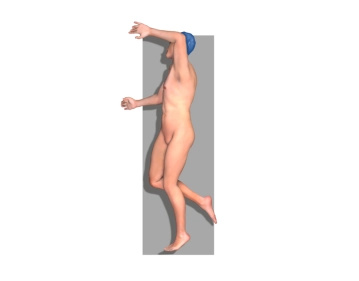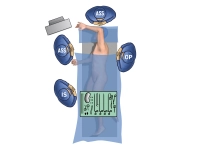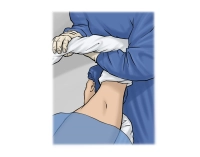The mean time spent before TOS is finally diagnosed is 4 years!
Medical history
- Broad variety of complaints since compression of the plexus, artery and vein can be concurrent - but to different degrees
- Isolated compression of the plexus, artery, or vein is exceedingly rare (also hard to imagine pathophysiologically), though compression of an anatomic structure may be the leading clinical symptom
1. Complaints due to plexus compression/irritation
- Triggered/aggravated by abduction of and downward traction on the arm
- Pain along the posterior aspect of the shoulder and axilla, radiating to the medial aspect of the arm, elbow, and eventually the 4th and 5th fingers
- Nocturnal tingling, numbness of the arm and pain at rest, especially after more demanding physical activity than normal
- Increased perspiration (due to irritation of the sympathetic fibers)
- Weakness and feeling of heaviness in the affected arm
- Loss of dexterity due to declining coordination of finger movements (objects are dropped or cannot be held anymore)
- Loss of fine motor skills (impaired writing, working with computers, etc.)
- Atrophy of the small muscles of the hand (rather late)
The mean time spent before TOS is finally diagnosed is 4 years!
Medical history
- Broad variety of complaints since compression of the plexus, artery and vein can be concurrent - but to different degrees
- Isolated compression of the plexus, artery, or vein exceedingly rare (pathophysiologically also hard to imagine), though compression of an anatomic structure may be the leading clinical symptom
1. Complaints due to plexus compression/irritation
- Triggered/aggravated by abduction of and downward traction on the arm
- Pain along the posterior aspect of the shoulder and axilla, radiating to the medial aspect of the arm, elbow, and eventually the 4th and 5th fingers
- Nocturnal tingling, numbness of the arm and pain at rest, especially after more demanding physical activity than normal
- Increased perspiration (due to irritation of the sympathetic fibers)
- Weakness and feeling of heaviness in the affected arm
- Loss of dexterity due to declining coordination of finger movements (objects are dropped or cannot be held anymore)
- Loss of fine motor skills (impaired writing, working with computers, etc.)
- Atrophy of the small muscles of the hand (rather late)
2. Complaints due to arterial compression
- Rapid fatigue, claudication-like complaints during work overhead
- Paleness and coldness of the hand
- Acrocyanosis, also necrosis due to embolic digital artery occlusion (e.g., because of thrombi in a dilated poststenotic subclavian artery or due to subclavian aneurysm)
3. Complaints due to venous compression
- Heaviness and feeling of tension in the affected arm, increasing in intensity during work overhead
- Bulging veins on the hand, upper arm and forearm
- Patients wake up in the morning with a swollen bluish arm
Inspection
- With the patient standing -> postural anomaly?
- Also: scapular winging after compression injury of the long thoracic nerve -> paralysis of the anterior serratus muscle
- Comparison of skin color, skin temperature and perspiration levels
- Increase in circumference and texture
- Increased venous marking
- Trophic disorders, muscle atrophy
- Look for signs of peripheral embolization suggestive of subclavian aneurysm (trash)
Clinical examination
- Gross motor skills when shaking hands and spreading the fingers
- Palpation:
- Neurovascular bundle often painful on pressure in the axillary and supraclavicular regions
- Tight trapezius muscle with superior margin painful on pressure
- Cervical rib may be palpable as a spring-like resistance in the supraclavicular region
- Complete pulse status and vascular auscultation
- Doppler occlusion pressure comparison of the brachial arteries
- Bilateral blood pressure comparison
- (Finger) oscillography
Provocation tests
1. Pulse palpation during elevation and abduction, Apley scratch test
- Pulse loss during elevation and abduction of the arm is meaningful only in the presence of corresponding clinical symptoms
- According to the literature, asymptomatic loss of pulse is observed in more than 30% of young adults!
2. AER test (Abduction, Elevation, Rotation)
- Suggestive of TOS
- Abduct both arms by 90°, with elbows flexed at right angles, forearm rotated outward (i.e. hands supinated)
- Strong fist clenching exercises in this position for 3 minutes
- Pain and tingling in the fingers, fatigue and feeling of heaviness
- In arterial compression, long lasting painful paleness
- Mostly venous compression manifesting as bulging carpal and brachial veins
- Test is negative in carpal tunnel syndrome, cubital tunnel syndrome and degenerative cervical spine changes
3. Elvey test (upper limb tension test, neurodynamic test)
- 90° abduction of arms and dorsal flexion of hands
- Sensitizing maneuver: Contralateral inclination of head / cervical spine
4. Wright hyperabduction test
- Pulse status of arm abducted up to 180° and rotated outward
- Test is positive in case of pulse loss
Imaging
- Provocation (elevation, retroversion) angiography (e.g. MRI) in TOS with vascular complications
- Provocation venography in TIS
- X-ray of upper thoracic aperture to rule out / confirm cervical ribs
- Chest X-ray in two views to rule out a Pancoast tumor in the differential diagnosis
- Differentiation from degenerative cervical spine syndromes ( X-ray of cervical spine, possibly CT/MRI)
- Color flow Doppler ultrasonography
- Functional arteriography and venography(in pain-inducing and sitting position)
- Selective arm angiography in peripheral occlusion
Neurologic examination
- Mandatory!
- Measure proximal conduction velocities of ulnar and median nerve
- Absence of delay does not rule out TOS!
- High-grade delay and already evident atrophy of small hand muscles = structural plexus lesion -> poor prognosis



